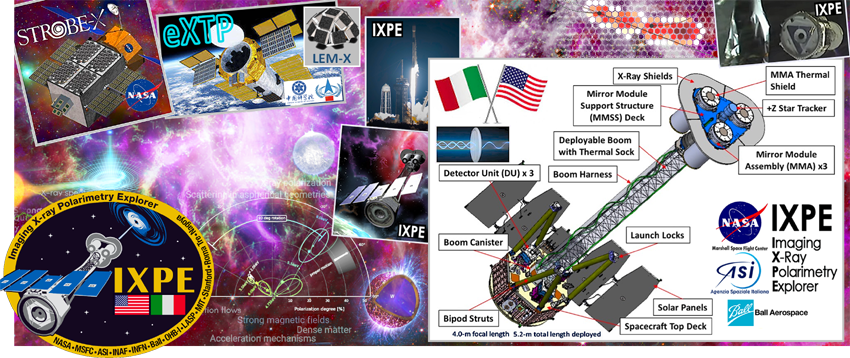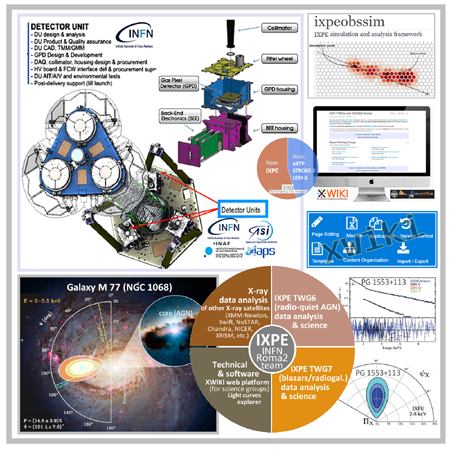
XRO, the USA-Italy IXPE satellite and next projects to observe X-rays from space.
The experimental XRO (X-ray Observatories) activity, includes the NASA-ASI Imaging X-ray Polarimetry Explorer (IXPE) satellite, launched on Dec. 9, 2021, and the Chinese enhanced X-Ray Timing and Polarimetry satellite (eXTP, launch around the year 2029). The collaboration to eXTP is now discontinued, with the ASI support ended last July 2024. The XRO activity now involves a study for a proposed NASA mission, the Spectroscopic Time-Resolving Observatory for Broadband Energy X-rays (STROBE-X).
In eXTP, Italy developed the demonstration model of the LAD (Large Area Detector) and the Detector Assembly of the WFM (Wide Field Monitor), the 2 European-led instruments of this next Chinese satellite. INFN worked on design and prototype of the Gas Pixel Detectors (GDP) for the polarimetry Focusing Array (PFA) instrument of eXTP. The programmatic decision of the Chinese Academy of Science was to place the 2 European instruments, LAD and WFM, among the optional payloads.
STROBE-X is an American probe-class project dedicated to timing and spectroscopic observations of X-ray sources in the sky in the X-ray window between 0.2 and 30 keV. INFN is developing and testing new ASIC (Application Specific Integrated Circuit) and GDP detectors, in view of a potential restart of the collaboration to eXTP and/or the next possible NASA selection of the STROBE-X mission proposal.
IXPE is a USA-Italy Small Explorer-class space mission, a collaboration between NASA and ASI, dedicated to the measure of X-ray polarimetry in the 2-8 keV band. The IXPE satellite has three identical X-ray-focusing grazing incidence telescopes, and three identical cameras and detectors, based on GDP photoelectric polarimeters, with spatial, temporal, energy (spectro-polarimetric) capabilities. The ASI funded the detectors units (DU) of IXPE, built and calibrated by INFN (Pisa and Torino sections) and INAF-IAPS.  INFN is responsible for the GDP detectors, construction and calibration, of the simulation and data analysis software, and the web platform for the international science collaboration. Since 2022, IXPE has observed the X-polarization state of more than a hundred violent and dense astrophysical objects with extreme gravitational, electric and magnetic fields: the Galactic center, neutron stars, magnetars, pulsar wind nebulae, microquasars, stellar black holes and the supermassive ones inside the active galactic nuclei (AGN). Some studies on quantum gravity effects, quantum electrodynamics (QED) vacuum birefringence and signals from Axion-Like Particles (ALPs) are also possible.
INFN is responsible for the GDP detectors, construction and calibration, of the simulation and data analysis software, and the web platform for the international science collaboration. Since 2022, IXPE has observed the X-polarization state of more than a hundred violent and dense astrophysical objects with extreme gravitational, electric and magnetic fields: the Galactic center, neutron stars, magnetars, pulsar wind nebulae, microquasars, stellar black holes and the supermassive ones inside the active galactic nuclei (AGN). Some studies on quantum gravity effects, quantum electrodynamics (QED) vacuum birefringence and signals from Axion-Like Particles (ALPs) are also possible.
The IXPE group of the INFN Roma Tor Vergata section, is active in this current IXPE data taking phase, being responsible for the user support, building and maintaining of the web platform of the seven topical working groups (TWGs) of science of the international collaboration, as well as participating in studies of supermassive black holes and AGN (radio-quiet and those with jets, i.e. blazars). As example the group led observations and data analysis of the flat spectrum radio quasar 3C 454.3 and the radio-quiet Compton-thick AGN Messier 77 (NGC 1068), and participated in the data analysis of very-high-energy blazars (1ES 1959+650 and PG 1553+113). Data analysis and interpretation, are also conducted through coordinated, multi-frequency, observations (polarimetry in radio waves and optical light from ground-based telescopes) and collecting simultaneous data from other X-ray satellites in flight (XMM-Newton, Swift, NICER, Chandra).
























































































